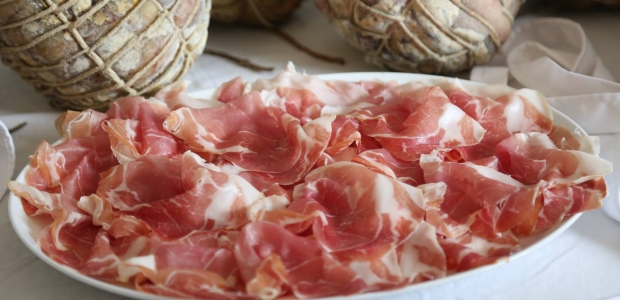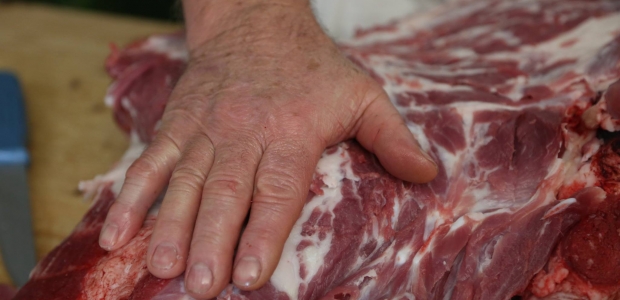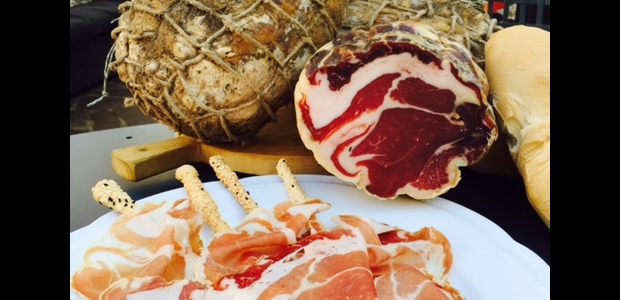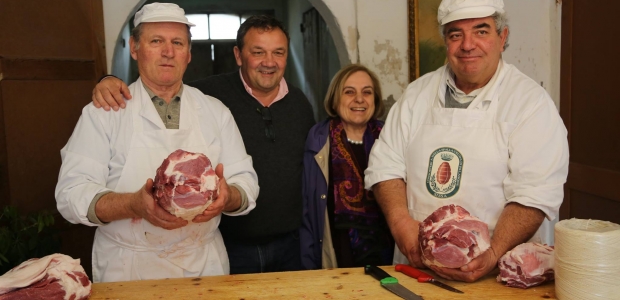Languages
Spalla Cruda (Raw Shoulder), a hidden treasure
A sweet, delicate and eventful story
Quoted in a document dated 1170, this cold cut is delicate and hard to maintain; with a sweet and delicate taste, tells in every slice the tumultuous history of these places and industriousness of the inhabitants.
Palasone was an important political and religious center in antiquity; rich in water and full of fertile lands, crossroads of armies and goods between the two banks of the Po, Palasone is mentioned several times in ecclesiastical documents. The first dates 25 March 999 on the day of San Lorenzo’s church construction beginning: "ubi nominatur Palazione vel pro eis territoriis quod est to ipsam Curtem et Capellam pertinentibus".
Closer to a daily life basic necessities than to the spiritual needs it’s another document. This old contract, dated 11 February 1170, specifies how the canons rented land in return of chickens, bread, eggs, shoulders, carriages, wine etc .: "tercium vini de quidam vinea Palacionis". This ancient parchment proclaims the existence of the most mysterious of the Parma salami, a gem of Bassa Parmense partially segregated by the mass explosion, among gourmets around the world, of the reputation of Culatello and the local recognition of the Spalla Cotta ("Cooked Shoulder") version, traditionally assigned to the town of San Secondo Parmense.
Spalla Cruda of Palasone and Sissa, therefore probably the most difficult pork’s products to find in this corner of the province of Parma, then had a long trajectory.
It originated, as happened to his well emblazoned cousin Splla Cotta, from the unfavorable weather conditions (hot and humid in summer and winter foggy), in contrast to the typical breezes of Parma’s hills. Thus the Spalla Cruda is stuffed into a pig's bladder and tied to be seasoned in damp and dark cellars in which the boundary between the floor and the water below is often limited to a few centimeters.
In two versions, boneless and with bone, starting from the front shoulder of heavy pigs, especially in the version with bone, the Spalla Cruda highlights all the butcher’s skills who has to make a very difficult cut an dry it properly, risking dangerous irrancidimenti, in particular the layer of fat that wraps around the sausage. For both versions, the production is concentrated in the winter months, in which the low temperatures help to preserve: the meat is slightly salty, during not more than five days, stuffed into natural bladder and tied manually. It has the same form of a Fiocco of Culatello, but you can distinguish thanks to a piece of rope dangling at the bottom. Only a few craftsmen keep alive the tradition of Spalla Cruda with bone, a product that is facing extinction even if in this historical moment the rediscovery of traditions at the table seems to become more and more widespread and thorough process.
In December 2006 the “Palasone-Sissa Spalla Cotta Coterie” was born, under the auspices of the Culatello Consorzio di Zibello DOP. Spalla Cruda, which is produced in this area, has to follow a precise voluntary regulation, which was adopted by the producers and the Consortium of Culatello of Zibello that certifies the quality of the results. The product bears the brand name adopted by the “Coterie of Spalla Cruda of Palasone” (which is based in Sissa) and can be produced only by the eight municipalities of the PDO Culatello or Polesine Parma, Busseto, Zibello, Soragna, Roccabianca, San Secondo, Sissa and Colorno. Upon completion of its maturation, a Spalla Cruda weighs between 2.5 and 3 kilograms, looks very sweet and delicate taste and it is advisable to cut it with a knife directly from the vise.









